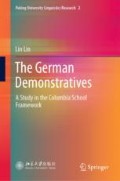Abstract
In this chapter, I will analyze the Chinese demonstratives using the Columbia School linguistic theory framework, as well as cognitive linguistic theory.
Access this chapter
Tax calculation will be finalised at checkout
Purchases are for personal use only
Notes
- 1.
For the sake of consistency, all names from the book Weicheng will be in Wade-Giles instead of pinyin because the English translation (Kelly & Mao, 1979) uses Wade-Giles.
- 2.
This is not just a Chinese cultural phenomenon and has such English equivalents as “the tallest blade of grass is the first to be cut.”
- 3.
“Women zhe wei laobo” is an appositive phrase, meaning ‘our this old family friend,’ literally.
- 4.
“Shuimian zhe dongxi” is an appositive phrase, meaning ‘sleep this thing,’ literally.
- 5.
Statistical analysis should be credited to Ruixue Fan, a statistician at Columbia University.
- 6.
[www.xiaonei.com] (March 18, 2009), http://abc.xiaonei.com/knowabc/investigation/Voted.action?invID=3847829.
- 7.
References
Diver, W. (1995). Theory. In E. Contini-Morava, B. Sussman Goldberg, & R. Kisner (Eds.), Meaning as explanation: Advances in linguistic sign theory (pp. 43—114). Berlin: Mouton de Gruyter.
Hayashi, M., & Yoon, K. (2006). A cross-linguistic exploration of demonstratives in interaction with particular reference to the context of word-formulation trouble. Studies in Language, 30(3), 480–540. https://doi.org/10.1075/sl.30.3.02hay.
Kirsner, R. S. (1993). From meaning to message in two theories: Cognitive and Saussurean views of the modern Dutch demonstratives. In R. A. Geiger & B. Rudzuke-Ostyn (Eds.), Conceptualizations and mental processing in language (pp. 80–114). Berlin: Mouton de Gruyter.
Langacker, R. W. (1987). The foundations of cognitive grammar: Theoretical prerequisites, vol. 1. Stanford: Stanford University Press.
Langacker, R. W. (1995). Raising and transparency. Language 71(1), 1.
Qian, Z. S. (1954). Weicheng. Shanghai: Chenguang Chuban Gongsi.
Qian, Z. S. (1979). Fortress besieged. J. Kelly. & N. Mao (Trans.). Taipei: Bookman Books.
Reid, W. (1977). The quantitative validation of a grammatical hypothesis. Columbia university working papers in linguistics, 4, 59–77. Retrieved from http://journals.tc-library.org/index.php/tesol.
Wang, L. (1959). Zhongguo xiandai yufa [Contemporary Chinese grammar] (Vol. 1–2). Hong Kong: Zhonghua Shuju.
Author information
Authors and Affiliations
Corresponding author
Rights and permissions
Copyright information
© 2020 Peking University Press
About this chapter
Cite this chapter
Lin, L. (2020). The Chinese Demonstratives. In: The German Demonstratives. Peking University Linguistics Research, vol 2. Springer, Singapore. https://doi.org/10.1007/978-981-13-8558-2_4
Download citation
DOI: https://doi.org/10.1007/978-981-13-8558-2_4
Published:
Publisher Name: Springer, Singapore
Print ISBN: 978-981-13-8557-5
Online ISBN: 978-981-13-8558-2
eBook Packages: Social SciencesSocial Sciences (R0)

